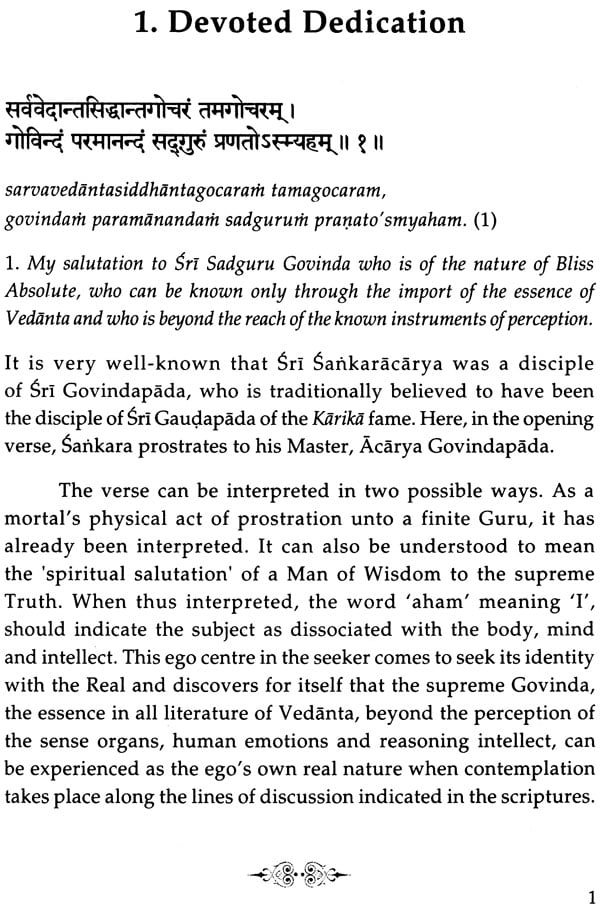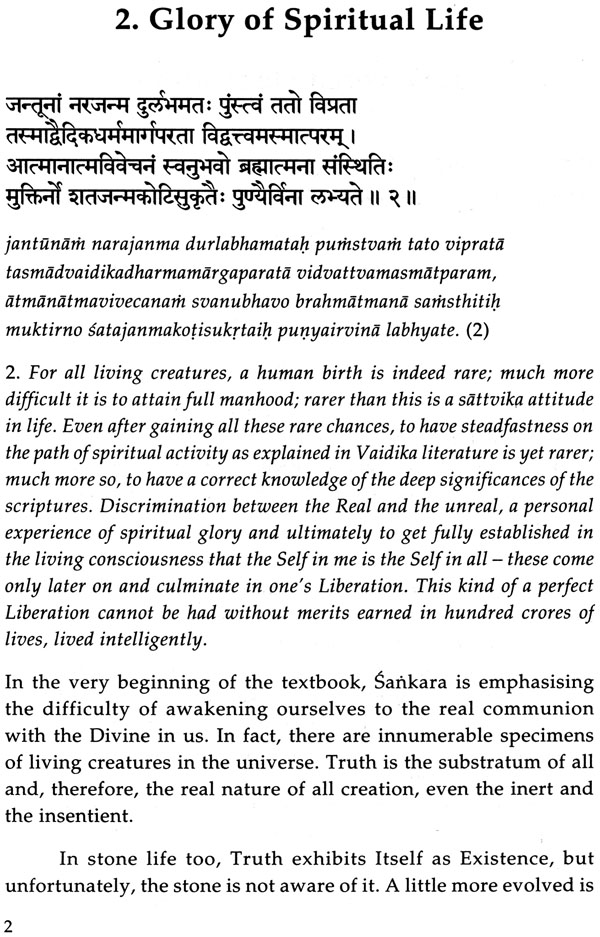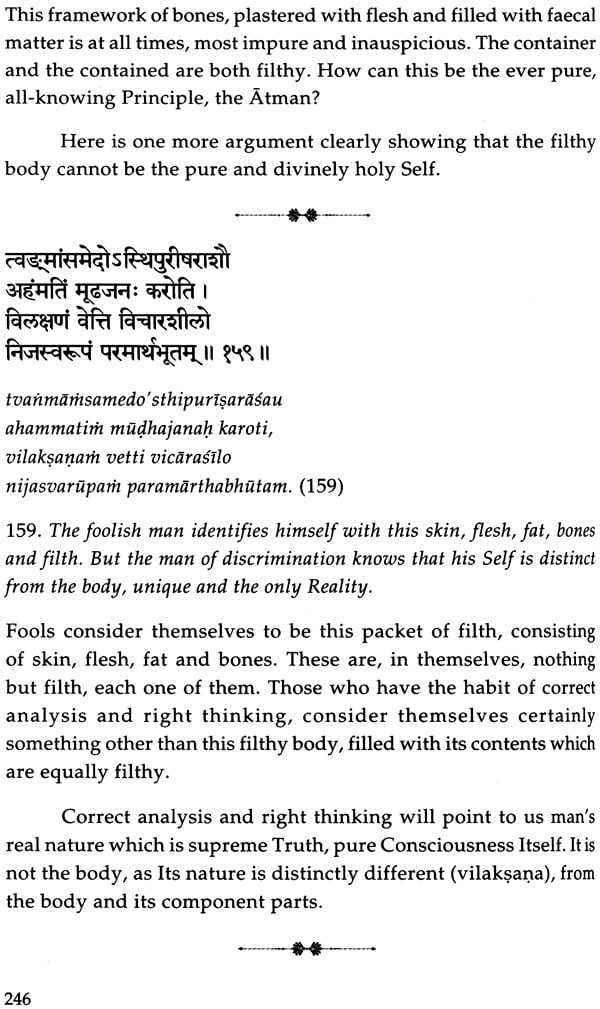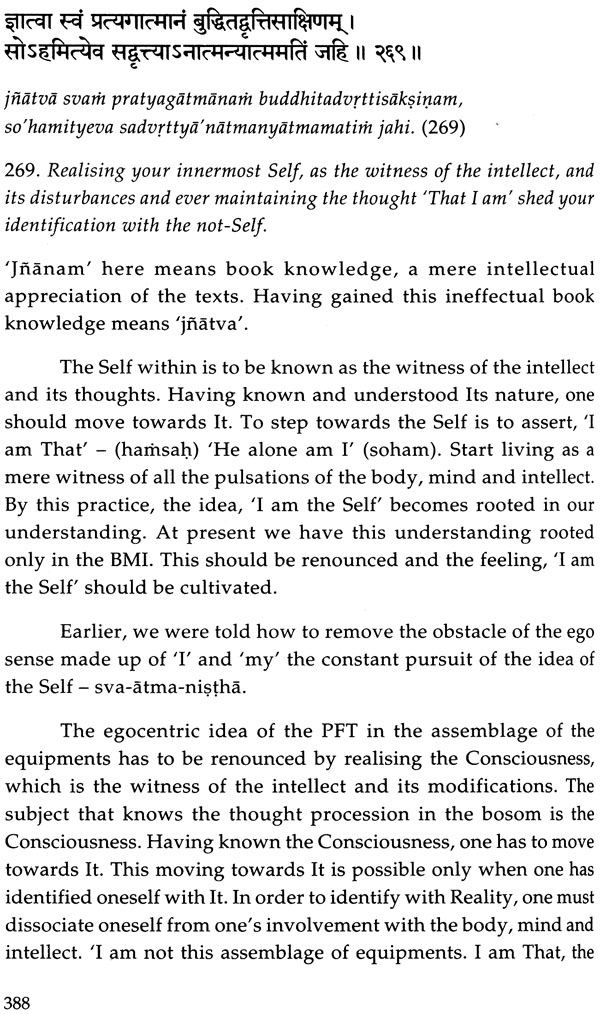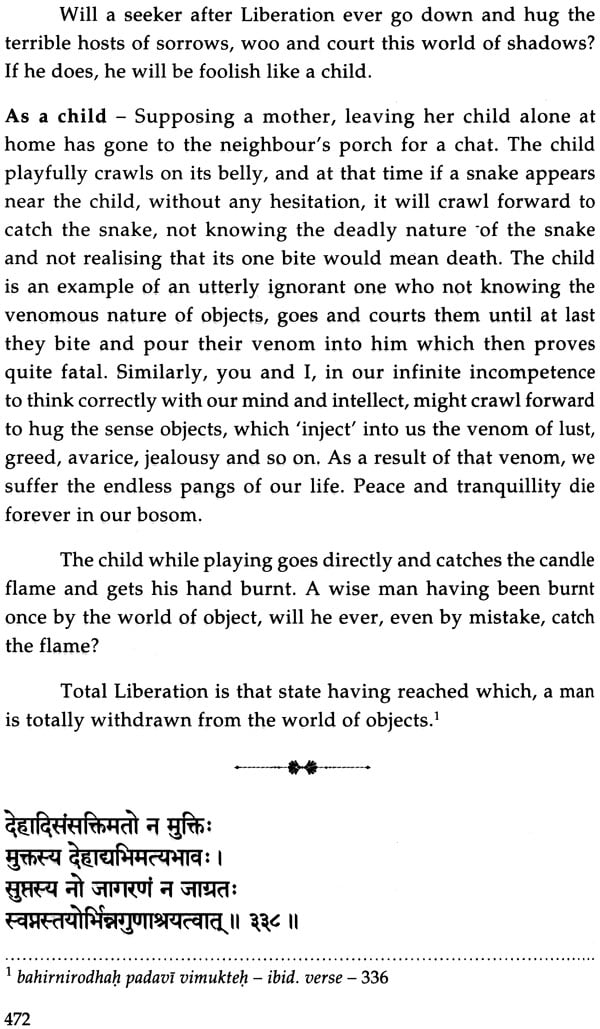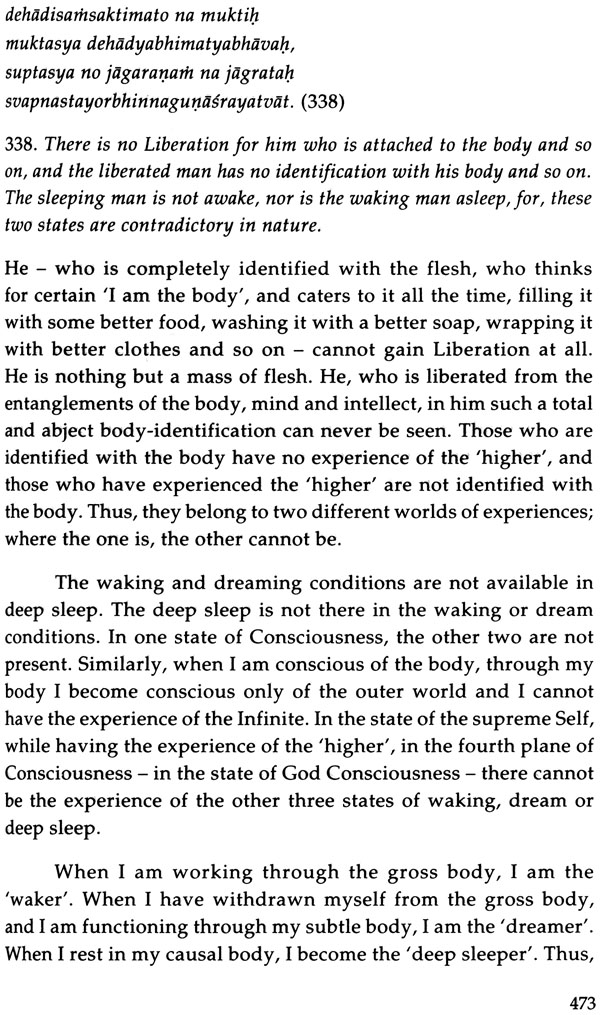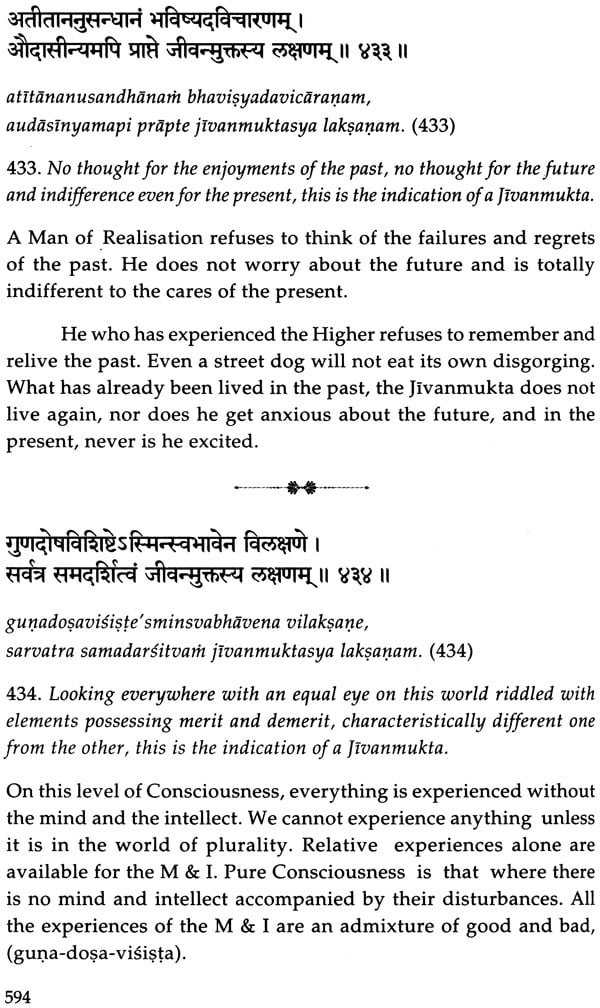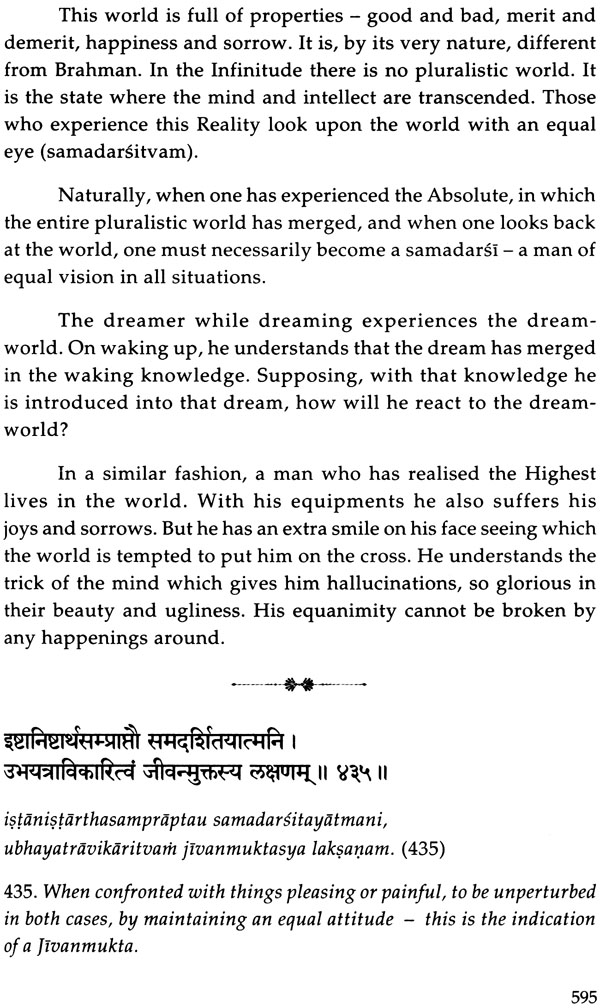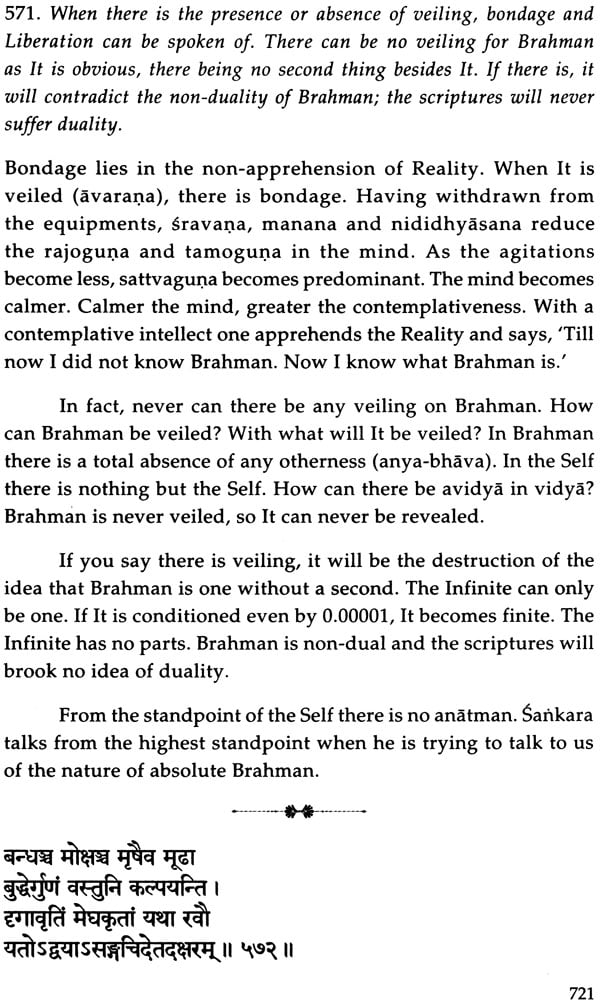
Vivekachoodamani (Talks on Sankara's Vivekachoodamani)
Book Specification
| Item Code: | IDC295 |
| Author: | Swami Chinmayananda Saraswati |
| Publisher: | CENTRAL CHINMAYA MISSION TRUST |
| Language: | English |
| Edition: | 2018 |
| ISBN: | 9788175971400 |
| Pages: | 625 |
| Cover: | Paperback |
| Other Details | 8.5" X 5.5" |
| Weight | 690 gm |
Book Description
Introduction
The study of any science cannot be undertaken without a preliminary understanding of the exact definitions of the terms and terminologies employed in it. The fundamental beliefs, the accepted theories, the observed modes of behaviour, are all necessary data with which a modern scientist freely launches his new adventure into the realm of science. Similarly, in philosophy also, a fundamental knowledge of the terms used and the correct connotations in which various terms have been employed, is an unavoidable preliminary before a student can start the study of Vedanta.
Vedanta is truly the “Science of Life”. Sankara, the great interpreter of Vedanta, not only gave us his commentaries on the Upnishads, the Brahma Sutras and the Bhagavad Gita, but also many primary texts which introduce the seeker into the joys of Vedanta. One of the greatest texts he has written as an introduction to Vedanta, is the Vivek-achoodamani means, “The Crest-Jewel of Discrimination”.
A careful study of these verses with the full freedom to enquire will give any student a correct understanding of the entire theory of Vedanta and he can, even without a very serious study of the scriptures, start his daily practices with tremendous benefit.
There are hundreds of seekers who, without understanding the fundamentals, are aimlessly struggling along a so-called spiritual path. Naturally, they suffer agonies of painful disappointment, although they have behind them, years of painstaking practices. An exhaustive and careful study of this text helps to avoid all pitfalls on the way to progress. It is my intention to bring forth from every verse not only its obvious meaning, but also it hidden import which gives out a wealth of information and helpful suggestions to ensure a steady progress. Along with the Sanskrit verse I have given a free translation and a running commentary wherein in have not confined myself to the direct bearings upon the words of verse. These verses have great suggestive wealth which, when made available, can profitably be made use of even in our day to day market place activities.
A word of advice : The seeker should carefully read three or four verses every day, and cogitate over them while pursuing his mundane activities. Only guide-lines are given here. Deep, independent thought by the reader is a must. Only then will there be satisfactory results.
It has been a painful ecstasy, all through the preparation of this manuscript. Painful because the commentaries were written during a confusingly long period of the last three or four years. I had first brought out the opening hundred verses in a volume but thereafter, the pressure of work being so great I could not find the necessary leisure for cogently expressing the pregnant suggestions of these brilliant verses of Acharya Sankara.
In order to drive home the philosophic meaning of these subtle verses, while talking to my students, in Sandeepany Sadhanalaya, I often had to repeat, and at moment I had even indulged myself in lengthy digressions. These lectures were taped.
All these furlongs of tapes were carefully and laboriously taken by Miss Kanta (Hawaii) with her tape-recorder and they were all industriously transcribed by two diligent members of the Mission-Sri Bhatia (Godrej) and Sri Radhakrishnan (Railways). These voluminous manuscripts were sent to Utterkasi when I was last there and to chop and slice them into shape was in fact more laborious than dictating the entire lot afresh.
In the final editing and preparation of the manuscript, Miss Bharathi Naik helped with great devotion.
I am conscious that there are very many jerks along the march of the commentaries upon these verses. Very often the style has conspicuously changed, and the treatment of the verses differs at more than one places in the text. I am conscious of these weaknesses, but I cannot help them as I had to take up the work between long intervals of suffocating work of the Yagnasalas.
However, when at Mysore I was flattened to my bed by the Cardiac Infraction, and when my rehabilitation in Bombay was slow, those tedious months were employed in shaping, out of the confused mass, this humble attempt. No doubt, it looks very beautiful to me; but can there ever be a mother who can see the ugliness of her own child?
It is a general courtesy to thank all those who helped us to bring out the book. I cannot follow this courtesy because if I have to thank, I must thank the thousands of students who assembled every morning to inspire me to express all I have recorded here. The first 100 verses that were brought out earlier, have been reedited and incorporated here into this volume.
To the student who is planning to read from the opening verse to the concluding verse 581, I have an apology to make. Such a student will find, at many places, ideas and thoughts repeated time and again deliberately. This is not a defect by oversight. This book is conceived and planned to help the Chinmaya Mission study-group-members, and repetition is the only method by which I can help them to reflect again and again upon the salient features of this great philosophy.
Secondly, every verse has been laboriously made complete in its commentary, as I feel that the majority of my reading a verse here and a verse there. If once they understand exhaustively any single verse at random, I know my work is done. Thereafter, the magic of Sankara will enchant such readers to take up an exhaustive study of the book.
Vivekachoodamani is the cream of the Upanishads and the Bhagavad Geeta. I re-educates the student, in a systematic way, to provide him with a new vision of life. The Goal and the Path are both exhaustively dealt with, in this elaborate treatment of Vedanta, by Acharya Sankara. To one, who is making a deep study of Vevekachoodamani, no other help is needed for leading him to a spiritual life and guiding him to his self improvement.
| Sec. 1 | Devoted Dedication | Verses. 1 | Pages 1 |
| 2 | Glory of Spiritual Life | 2 | 2 |
| 3 | Unique Graces In Life | 3 | 7 |
| 4 | Miseries of The Unspiritual Man | 4-7 | 8 |
| 5 | Means Of Wisdom | 8-13 | 16 |
| 6 | The Fit Student | 14-17 | 24 |
| 7 | The Four Qualifications | 18-30 | 31 |
| 8 | Bhakti - Firm And Deep | 31 | 49 |
| 9 | Courtesy Of Approach And Questioning | 32-40 | 51 |
| 10 | Loving Advice of The Guru | 41-47 | 64 |
| 11 | Questions of the Disciple | 48-49 | 74 |
| 12 | Intelligent Disciple - Appreciated | 50 | 77 |
| 13 | Glory of Self - Effort | 51-55 | 78 |
| 14 | Knowledge of the Self - Its Beauty | 56-61 | 82 |
| 15 | Direct Experience; Liberation | 62-66 | 90 |
| 16 | Discussion on Question Raised | 67-71 | 97 |
| 17 | Gross Body | 72-75 | 106 |
| 18 | Sense - Objects, A Trap : Man Bound | 76-82 | 112 |
| 19 | Fascination For Body Criticised | 83-86 | 122 |
| 20 | Gross Body Condemned | 87-91 | 126 |
| 21 | Organs Of Perception And Action | 92 | 130 |
| 22 | Inner Instruments | 93-94 | 131 |
| 23 | The Five Pranas | 95 | 133 |
| 24 | Subtle Body : Effects | 96-101 | 134 |
| 25 | Functions of Prana | 102 | 139 |
| 26 | Ego Discussed | 103-105 | 140 |
| 27 | Infinite Love - The Self | 106-107 | 143 |
| 28 | Maya Pointed Out | 108-110 | 147 |
| 29 | Rajoguna - Nature And Effects | 111-112 | 153 |
| 30 | Tamoguna - Nature And Effects | 113-116 | 154 |
| 31 | Sattwaguna - Nature and Effects | 117-119 | 158 |
| 32 | Causal Body - Its Naure | 120-121 | 164 |
| 33 | Not - Self - Description | 122-123 | 165 |
| 34 | The Self - Its Nature | 124-135 | 167 |
| 35 | Advice For Self - Control | 136 | 180 |
| 36 | What Is Bondage? The Reply | 137-142 | 182 |
| 37 | The Powers : Agitation and Veiling | 143-144 | 194 |
| 38 | Bondage In Action | 145-146 | 196 |
| 39 | Atma And Anatma - Discrimination | 147-153 | 200 |
| 40 | Negation of the Five Kosas | 208 | |
| (a) Annamaya Kosa - Food Sheath | 154-164 | 208 | |
| (b) Pranamaya Kosa - Vital - Air Sheath | 165-166 | 219 | |
| (c) Manomaya Kosa - Mental Sheath | 167-183 | 221 | |
| (d) Vignanamaya Kosa - Intellectual Sheath | 184-188 | 240 | |
| 41 | Atman-Unattached | 189-191 | 245 |
| 42 | What Is Liberation ? - Disciple | 192-193 | 249 |
| 43 | Self-Knowledge Gives Liberation | 194-206 | 250 |
| 44 | Anandamaya Kosa - Bliss Sheath | 207-210 | 262 |
| 45 | Atman - Other Than The Five Kosas | 211 | 267 |
| 46 | What Is Atman ? - Disciple | 212 | 268 |
| 47 | Nature Of The Self - Discussion | 213-225 | 268 |
| 48 | All Manifestation Absolute | 226-236 | 283 |
| 49 | Brahman - Its Nature | 237-240 | 291 |
| 50 | That Thou Art - Explanation | 241-249 | 296 |
| 51 | Attitude In Meditation | 250-253 | 310 |
| 52 | Aids to Meditation | 254-266 | 314 |
| 53 | Give Up Vasanas - The Method | 267-276 | 329 |
| 54 | End Superimposition - The Means | 277-292 | 339 |
| 55 | The Perceived “I” Factor - False | 292-297 | 354 |
| 56 | Condemnation Of The Ego | 298-309 | 359 |
| 57 | Actions, Thoughts & Vasanas - Renounce | 310-319 | 369 |
| 58 | Total Vigilance - Its Price | 320-329 | 382 |
| 59 | In The One, No Plurality | 330-338 | 393 |
| 60 | Spiritual Growth - The Secret | 339-348 | 407 |
| 61 | Cause - Effect -False | 349-353 | 420 |
| 62 | Samadhi Its Nature | 354-372 | 427 |
| 63 | Fully Detached - Samadhi easy | 373-378 | 449 |
| 64 | Meditation - The Technique | 379-383 | 456 |
| 65 | Continuous Attention To the Self | 384-397 | 459 |
| 66 | No Diversity In Reality | 398-406 | 473 |
| 67 | Atma - Vichar - Contemplation | 407-413 | 478 |
| 68 | Give Up Perceptions | 414-418 | 486 |
| 69 | The Science Of Reality - Its Benefits | 419-425 | 492 |
| 70 | Signs Of A Realised Seer | 426-445 | 500 |
| 71 | Prarabdha For A Saint | 446-464 | 517 |
| 72 | There Is No Plurality | 465-471 | 536 |
| 73 | Experience Of Self - Hood | 472-479 | 541 |
| 74 | Practice Of Knowledge - Disciple | 480-520 | 548 |
| 75 | Final words of Advice | 521-575 | 578 |
| 76 | Blessed Disciple Liberated | 576-578 | 619 |
| 77 | The Glory of the Text - Book | 579-581 | 621 |
